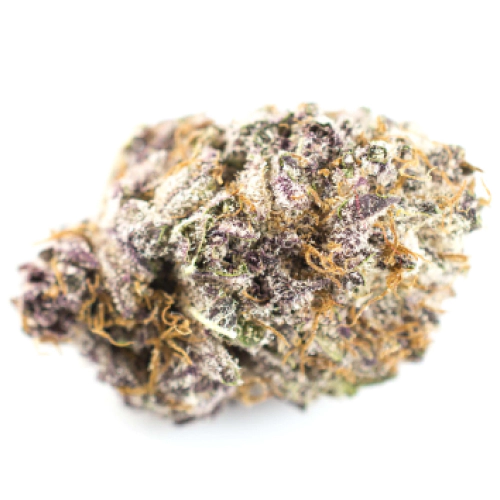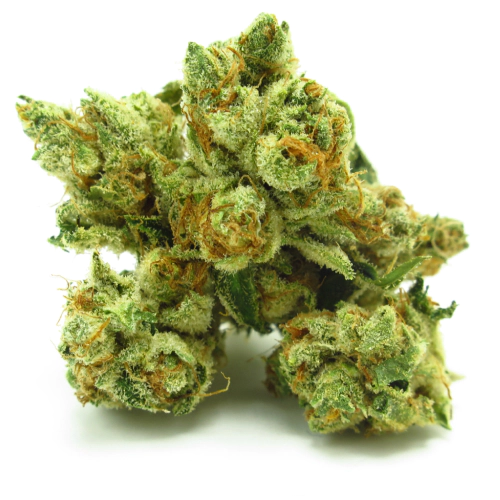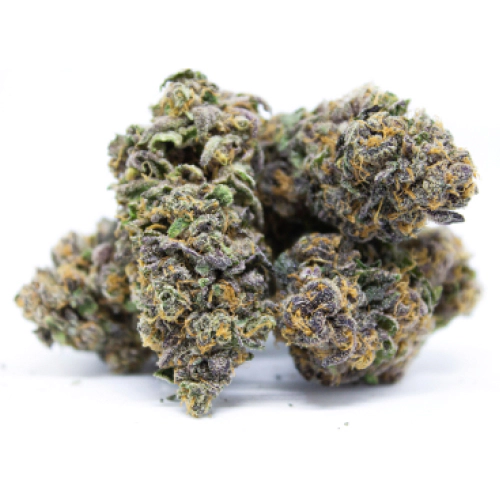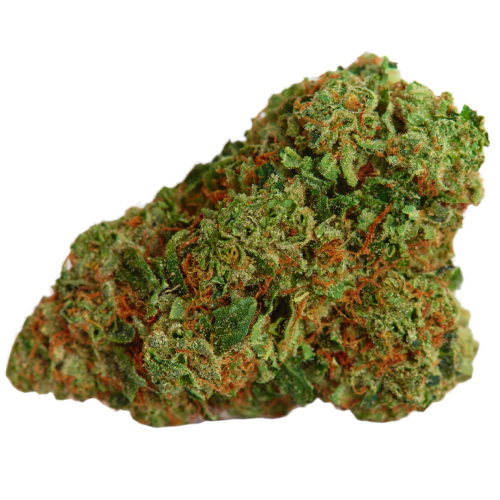Pina Collision Piña Collision
Cannabinoid THC Dominant
THC 14.83 - 13%
CBD 0.18 - 0.43%
Effect Giggly
Side Effect Rapid heart beat
Flavor Sweet
All About Pina Collision Weed Strain
THC
CBD
Potency
Pina Collision strain was created from Jamaican Pineapple and Blue Nebula crossing and endowed with 70% Sativa dominance. The THC level does not exceed 15%, CBD amount is 0.18-0.43%. This weed is ideal for all smokers regardless of experience. Everyone will find something special in its multifaceted buzz.
The dominant terpenes that determine the properties of Pina Collision cannabis are the following:
- Myrcene
- Eucalyptol
- Caryophyllene
- Bisabolol
Aroma and Flavors
Piña Collision is the perfect choice for people looking for delicious and aromatic cannabis. A fabulous aroma of tropical fruits with earthy herbal undertones is born when the buds are ignited. The taste is also seductive: you can feel pineapple, mango, coffee, and menthol notes.
Pina Collision Weed Strain Effects
The weed provides an incredible combination of energizing and inebriation, perfect for situations where you need to get out somewhere. The high is fast and intense, accompanied by bursts of euphoria. You will feel astounding energy and readiness to complete all the planned tasks. Pina Collision strain is ideal for going to a nightclub, a party, or a concert.
However, be careful if you suffer from paranoia or anxiety disorder because the weed can exacerbate the symptoms of panic.
Common Usage
The healing properties of this cannabis strain help to cope with several diseases. People use it effectively in neutralizing the symptoms of the following ailments:
- Stress
- Fatigue
- Epilepsy
- Hypertension
Growing Info
Piña Collision weed is easy to grow. The flowering period begins on day 62, and on day 69, as a rule, the plant produces a crop. Outdoors, you can harvest about 550 g/plant. The yield indoor is 400 g/m2. The kush can reach 60-80 inches in height.
Side Effects
Simply let us know how this strain tastes or write a detailed review.
Pina Collision Strain Cannabinoids
| THC | Tetrahydrocannabinol, or THC, is a major cannabis chemical compound. It is a psychoactive element that stimulates dopamine release and induces euphoria or happiness. THC-rich strains may be helpful with such conditions as lack of appetite, chronic pains , etc. It is considered to be the primary active marijuana component. | 14.83 - 13% |
| CBD | Cannabidiol, or CBD, is a major compound in cannabis, which is non-psychoactive. It is also proved to counteract the side effects of the second major component THC. CBD is widely used for medicinal purposes in rubs, oils and so on. It is helpful in muscle pain cases, may treat arthritis and migraines. Even Greeks used it against pain, while Queen Victoria applied it to get rid of menstrual cramps. | 0.18 - 0.43% |
| CBC | Cannabichromene, or CBC, is a minor cannabinoid, meaning that its quantity in cannabis is quite little. Though it has the same origin as CBD and THC, it is different in functions. Without any psychoactive effects, it is an efficient cannabis compound in combating acne and depression. CBC produces analgesic, antibacterial and anti-inflammatory effects. | 0.24 - 0.44% |
| CBG | Cannabigerol, or CBG, is one of the minor cannabis compounds in adult plants. On the other hand, young ones contain a lot of this antibacterial and anti-inflammatory component. During the growth, CBG is converted into different cannabinoids, mostly THC and CBD. The compound itself increases appetite and decreases eye pressure. | 0.26 - 0.7% |
| CBN | Cannabinol, or CBN, is a trace element in cannabis that is considered to be mildly psychoactive. It appears from oxidation THC, exposed to light and heat. CBN is mostly contained in old cannabis and in traditional hashish. It is effective against insomnia, bacterial infections and appetite loss. | 0.3 - 0.24% |
| THCV | Tetrahydrocannabivarin, or THC-V, is a compound contained in cannabis in trace amounts. Even though it is close to THC molecularly, it is different in effects. This compound may be psychoactive only in large amounts. THC-V reduces blood sugar, controls appetite, stimulates bone growth, etc. African Sativa strains are the richest in THC-V. | 0.36 - 0.51% |
Pina Collision Terpene Profile
| Pinene | Pinene is one of the most widespread terpenes in nature, found in pine trees, basil, nutmeg, parsley, and rosemary. Cannabis containing terpene (alpha-pinene or α-pinene) boasts a strong pine scent. Pinene is responsible for anti-inflammatory, pain-relieving, and anti-anxiety effects. | 0.02% |
| Myrcene | Myrcene (also known as β-myrcene) is one of the most common terpenes found in cannabis, representing more than 20% of the modern marijuana terpene profile. Myrcene has a distinct earthy, musky flavor, resembling cloves. It is responsible for calming and soothing effects of weed. Myrcene is also found in hops, thyme, mango, lemongrass, guava melon. | 0.34% |
| Ocimene | Ocimene (derived from the Ancient Greek word Ocimum meaning basil) is a terpene with sweet and herbaceous flavors, also boasting citrusy and woody undertones. Naturally, ocimene occurs in mint, parsley, orchids, hops, kumquats, mangoes, basil, bergamot, lavender, and pepper. Offers antifungal, anti-inflammatory, and antiviral properties. | 0.09% |
| Humulene | Humulene (also known as α-humulene) is one of the major terpenes found in cannabis, contributing to woody, earthy, spicy, herbaceous, and, mainly, floral aromas of cannabis. Used in modern medicine, humulene offers anti-inflammatory, antibacterial, and appetite suppressant effects, which have been well-researched by pharmaceutical companies. | 0.04% |
| Limonene | Limonene (also known as d-limonene) is the second most common terpene in nature and the third most common terpene in cannabis. It has a powerful citrus aroma and can be found in all citruses, including lemons, oranges, grapefruits, limes, juniper, etc. Limonene is known to elevate moods and provide anxiety, depression, and stress relief. | 0.08% |
| Bisabolol | Bisabolol (also known as α-Bisabolol or levomenol) is a lesser-known terpene found in cannabis. It contributes to anti-inflammatory, anti-irritant, antioxidant, anti-microbial, and analgesic properties of weed strains containing bisanol. Attentive smokers would be able to catch a nutty, fruity scent with herbal and floral undertones, with a tender trace of coconut. | 0.1% |
| Eucalyptol | Eucalyptol (also known as cineole) is usually found in eucalyptus, mint, sage, and tea tree oil. Distinguished for its cooling properties, eucalyptol constitutes only up 0.6% of a total terpene profile of a strain. This terpene exhibits potent antibacterial effects and can also be used to treat patients with Alzheimer's disease and asthma. | 0.2% |
| Caryophyllene | Caryophyllene (also known as beta or b caryophyllene) is a terpene found in many herbs and spices, such as black pepper, basil, rosemary, and oregano. Cannabis high in caryophyllene delivers a strong spicy, peppery aroma, resembling cinnamon and cloves. Caryophyllene offers potent anti-inflammatory and sedative effects. | 0.12% |
| Total terpenes content | 0.99% |
Growing Info
Pina Collision strain lineage
Similar Strains
THC 20 - 21.5%
CBD 0.29 - 0.77%
Effect Calm
Flavor Woody
THC 22 - 22%
CBD 0.89 - 1.03%
Effect Happy
Flavor Lime
THC 13 - 17.5%
CBD 0.3 - 0.42%
Effect Talkative
Flavor Skunk
THC 14 - 16.6%
CBD 0.16 - 0.42%
Effect Talkative
Flavor Spicyherbal
THC 18 - 20.33%
CBD 0.49 - 0.82%
Effect Tingly
Flavor Spicyherbal
THC 19 - 24%
CBD 0.69 - 1.34%
Effect Sleepy
Flavor Pear
THC 20 - 23.5%
CBD 0.28 - 0.62%
Effect Happy
Flavor Berry
THC 12.3 - 16.39%
CBD 0.02 - 0.29%
Effect Hungry
Flavor Pine

THC 18.75 - 22.5%
CBD 0.34 - 0.72%
Effect Tingly
Flavor Nutty









Be the first and share your opinion
Write a Review